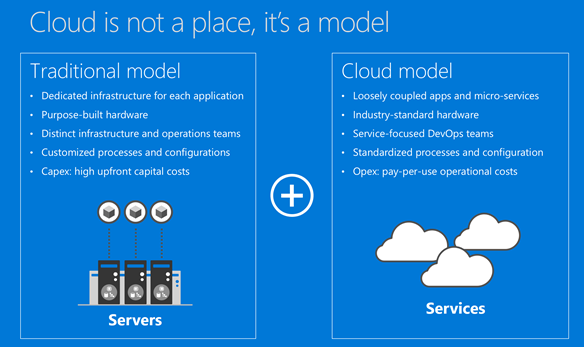Contents
Private or hosted
Big guy
Deploying Azure Stack yourself and aligning the business requires a large capital investment. It depends on the initial deployment, but we can assume that a game changing product such as Azure Stack, which can be instantly extended by adding physical servers, will over time grow beyond a rack and eventually ends up as a large investment. This well-thought investment is often reserved for larger companies with in-house IT departments where local Azure Stack deployment makes more sense. Most of them already consume public cloud services like Azure and directly profit from all the added benefits when they are able to consume the same services with dedicated resources locally in their own private cloud. A dedicated private cloud serviced by a local cloud service provider could also be an option when an investment in hardware, data center capacity or staffing is too costly for them.
Small guy
For companies without a huge IT budget or resources who simply cannot deploy and maintain such an environment are not left behind. They are able to consume the same Azure services with a pay-per-use subscription more locally at a cloud service provider in a shared hosted cloud or dedicated private cloud. A provider who already made these large investments. Why try to do it yourself when you can benefit from their guidance and expertise. Cloud service providers not only provide Azure services more locally, but also deliver a range of new offerings and managed services with it, which is something Azure public will not provide. Providing customers finished managed services so end users can innovate and IT has the stability and control that is required in their operations. Cloud service providers or cloud consultancy parties are also able to help customers with their Hybrid cloud consumption journey, interconnect their Clouds and give expert advice. For example, advice in how to deploy certain workloads and how they can move applications from traditional infrastructure to ‘Infrastructure as a Service’ (IaaS), ‘Platform as a Service’ (PaaS) or to Software as a Service (SaaS). Supporting and educating customer IT staff, helping them with their IT transformation. Not only a technical transformation but also a cultural one, opening up new opportunities, ideas and a new way of thinking about their business. This initiates a technological shift from the traditional IT infrastructure model to a Cloud consumption one.
It’s a new model
If you look at clouds today the two models below are in essence the difference between private and public clouds. For most private clouds it’s all about the infrastructure, public cloud is all about the service and application. This changes when you bring cloud software from the public cloud to private and hosted clouds. Suddenly the public cloud model is available in other clouds.
Traditional model
The traditional model facilitates in resolving custom traditional IT processes, and each application belongs to designated custom-built enterprise grade servers. It is a viable and proven model for the majority of applications and currently acceptable in industry. It has its purpose and solves many issues IT faces today. However, technology changes rapidly, now more than ever, by being influenced by hyper-scale advancements made in the public cloud. In this new age of apps, the old way of deploying infrastructure is causing friction because IT is not moving as fast as businesses desire.
Cloud consumption model
Apps are overwhelmed with unprecedented innovation or ‘digital transformation’ occurring around us. Innovations fueled by big software and cloud companies automate every process to run their clouds as efficiently possible at unimaginable scales. They all run in a cloud (consumption) model running on industry standard white box or open-compute servers where it’s all about the loosely couple applications or micro services. Being untied from servers, they are moved up the ladder by clever software now managing these servers and tied to a cloud service instead. This automated cloud service now consumes resources from the servers it controls underneath.
The cloud model is geared for speed; the server is no longer the center point. It allows the IT department to go deep on the cloud model, transitioning to DevOps practices. Practices inherited from this cloud model easily allow IT Pro’s and Developers to automate their infrastructure and application deployments with code. Knowledge and investments otherwise spent in IT infrastructure is now spent in making use and adopting new cloud technologies that would otherwise be untouched in a traditional model, holding back innovation. IT department knowledge and expertise are evolving and used more efficiently in the cloud model, which allows them and the company to move faster. This results in more innovation, new technologies and faster release cycles delivering more and better products. DevOps being a buzzword for many, finally has become mainstream for many IT teams undergoing the cultural shift by transitioning to the cloud model for their IT. It allows them to embrace agile development and increasing efficiencies across the IT organization. For many companies and certainly larger software companies, they need innovation to counter competitive threats and increase growth to survive. The only way to do that effectively is in a cloud (consumption) model which removes the burden of configuring and managing any infrastructure components, which lets them focus on the business value of the application. In addition, they can reinvent their product by using new applications, services and technologies inherited from the Cloud model, and they can create an even more innovative, complete and versatile product ready to compete in the changing market.
Hybrid, Private, Public or Hosted Cloud. Look at its model and the solution it brings to your organization.

